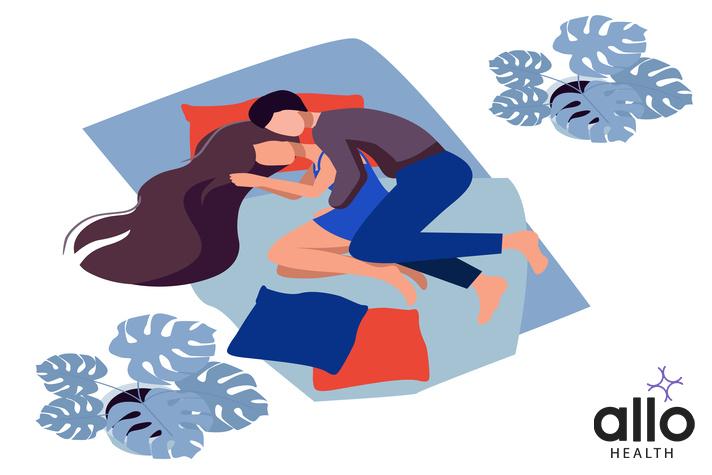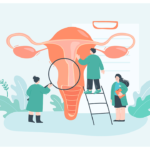Treatment For Vaginismus

Allo Health is dedicated to personalized well-being, offering support and trusted information tailored to individual health goals. The platform emphasizes human-generated content, led by a distinguished medical team of experts, including physicians and sexual health specialists. Their commitment to credibility involves rigorous fact-checking, authoritative research, and continuous updates to ensure accurate, up-to-date information. Allo Health's unique approach goes beyond conventional platforms, providing expert-led insights and a continuous commitment to excellence, with user feedback playing a crucial role in shaping the platform's authoritative voice.

A Psychotherapist with Clinical specialization, working for over seven years now. Areas of specialization range from Anxiety-related disorders, Mood-related disorders, Personality disorders, Sexual dysfunctions & other mental health issues.
Why This Was Upated?
Our experts continually monitor the health and wellness space, and we update our articles when new information became available.
Updated on 17 June, 2024
- Article was updated as part of our commitment to diversity, equity, and inclusion.
"The following blog article may discuss medical treatments and interventions. However, it is important to note that the information provided is for general educational purposes only and should not be considered as a substitute for professional medical advice, diagnosis, or treatment. Always seek the guidance of a qualified healthcare professional for personalized medical advice.
Book consultation
Medical treatments are complex and should be tailored to individual circumstances. The information presented in this blog may not be applicable to everyone, as each person's medical condition, history, and needs are unique. Only a qualified healthcare professional can evaluate your specific medical situation, consider relevant factors, and provide appropriate recommendations for diagnosis, treatment options, and monitoring.
It is crucial to note that self-diagnosis, self-medication, or relying solely on the information provided in this blog for treatment decisions can have serious health consequences. "
Vaginismus is a sexual disorder that causes the vaginal muscles to involuntarily contract, making it difficult or impossible for a woman to have sexual vaginal penetration or painful intercourse and during undergo gynecological exams. This can be a physically and emotionally distressing condition that can have a negative impact on a woman’s quality of life. There are several interventions that can be effective in treating vaginismus and helping women overcome this condition. Vaginismus treatment is chosen depends on the depends on the severity of the disorder symptoms
Vaginismus: Are There Examinations Required?
Yes, there are examinations that may be required to diagnose and assess vaginismus. Vaginismus is a condition characterized by involuntary muscle spasms in the pelvic floor muscles, specifically the muscles around the vagina, which can make penetration or any form of vaginal insertion painful or impossible. It is important to note that only a healthcare professional can provide an accurate diagnosis.
When you suspect you may have vaginismus, it is recommended to consult with a healthcare provider, such as a gynecologist or a urologist specializing in female pelvic medicine. During the examination, the healthcare provider will typically take a detailed medical history, asking questions about your symptoms, sexual history, and any relevant psychological or emotional factors.
The physical examination for vaginismus may involve a pelvic exam. The healthcare provider may use a gloved finger or a small device called a speculum to assess the vaginal opening, check for any physical abnormalities, and evaluate muscle tone. This can help confirm the presence of vaginismus and rule out other potential causes of pain or discomfort.
In some cases, additional diagnostic tests or assessments may be recommended to rule out other conditions or to evaluate the severity of vaginismus. These may include:
- Vaginal swab or cultures: These tests are performed to check for infections or other conditions that could contribute to vaginal pain.
- Imaging studies: In certain cases, imaging techniques like ultrasound or magnetic resonance imaging (MRI) may be used to examine the pelvic area and rule out any structural abnormalities or underlying conditions.
- Psychological evaluation: Since vaginismus can have psychological and emotional components, a healthcare provider may refer you to a mental health professional for a psychological assessment. This can help identify any underlying psychological factors or past experiences that may contribute to the condition.
Types Of Penetration That Hurt With Vaginismus
Vaginismus is a condition characterized by involuntary muscle spasms in the pelvic floor muscles, specifically the muscles surrounding the vagina. These spasms can make penetration or any attempt at vaginal entry painful, difficult, or impossible. The severity of vaginismus can vary from mild discomfort to severe pain.
When it comes to types of penetration that can be painful for individuals with vaginismus, it’s important to note that the specific triggers can vary from person to person. However, here are some general types of penetration that may be uncomfortable or painful for individuals with vaginismus:
- Penetrative intercourse: This refers to the act of vaginal penetration during sexual intercourse. Individuals with vaginismus may experience pain or extreme discomfort when attempting penetration, which can make sexual intercourse challenging or impossible.
- Insertion of tampons: Some individuals with vaginismus may find it painful or difficult to insert tampons into their vagina. The muscle spasms can make it hard for them to relax the muscles and allow the tampon to enter comfortably.
- Gynecological examination: Pelvic examinations, including the use of a speculum, can be painful for individuals with vaginismus. The insertion of the speculum or any medical instrument into the vagina can trigger muscle spasms and cause discomfort.
- Finger penetration: Attempting to insert fingers into the vagina, whether for sexual stimulation or self-exploration, can be painful for individuals with vaginismus due to the involuntary muscle contractions.
- Use of sex toys: Some individuals with vaginismus may experience pain or discomfort when attempting to use vaginal sex toys. The size and shape of the toy, as well as the level of control the person has over the insertion, can affect the level of pain experienced.
Vaginismus Treatment Options
Pelvic floor physical therapy
This type of therapy involves exercises and techniques to strengthen and relax the muscles of the pelvic floor. Pelvic floor physical therapy can help women with vaginismus learn to control their muscle contractions, pelvic pain and improve their ability to have pain-free intercourse.
Vaginal dilators
These are devices that are inserted into the vagina to help stretch and relax the muscles. Vaginal dilators are often used in conjunction with other treatment methods, such as CBT or pelvic floor physical therapy. Contrary to popular belief dilators are not scary and individuals can be guided by professionals.
Medicative Intervention
Medications may also be used to treat vaginismus. Antidepressants, such as selective serotonin reuptake inhibitors (SSRIs), can help relax the muscles in the vagina and reduce anxiety. Topical anesthetics can also be applied to the vagina to reduce pain during intercourse.
It’s important to note that vaginismus is a complex condition and treatment may involve a combination of these interventions. It’s also important to work with a healthcare professional who has experience in treating vaginismus and can provide personalized care. With the right treatment, many women are able to overcome vaginismus and improve their sexual and reproductive health.
Cognitive-behavioral therapy (CBT) Vs Acceptance and Commitment Therapy (ACT)
This type of therapy aims to help women understand and change negative thought patterns and behaviors that contribute to vaginismus. CBT may involve individual or group therapy sessions and may involve exercises such as progressive muscle relaxation, visualization, and exposure therapy
Cognitive therapies can be an effective treatment delivery for vaginismus, a condition in which involuntary spasms cause the muscles in the vagina to tighten, making sexual intercourse or other forms of penetration painful or impossible.
CBT involves identifying and challenging negative beliefs and assumptions about sex and the body, and developing coping strategies to manage anxiety and discomfort. This can involve exercises to relax the vaginal muscles and desensitization techniques to gradually increase comfort with penetration.
ACT, on the other hand, focuses on increasing an individual’s ability to accept and cope with difficult thoughts and feelings about sex and the body, rather than trying to change them. This can involve mindfulness and other strategies to help individuals let go of avoidance behaviors and move towards their values and goals.
Both CBT and ACT have been shown to be effective in treating vaginismus and other sexual dysfunction disorders. It’s important to work with a trained mental health professional who has experience with these therapies to ensure that treatment of vaginismus should be tailored to the individual’s specific needs and goals.
While cognitive behaviour therapy can be an effective treatment option, it’s important to remember that they are just one part of a comprehensive approach to managing vaginismus. Other treatments may include pelvic floor physical therapy, medication, and communication and relationship counseling with a partner. It’s important to work with a healthcare professional to determine the best treatment plan for your needs.
Sex therapy
A sex therapist can work with individuals with vaginismus to address any underlying emotional or psychological concerns that may be contributing to the condition and to develop coping strategies and communication skills to improve their sexual relationships.
Systematic or Progressive Desensitization
This therapy involves gradually exposing the individual to the feared stimulus (in this case, sexual intercourse) in a controlled and supportive environment, with the goal of reducing anxiety and increasing tolerance.
Sex After Vaginismus Treatment

Vaginismus is a condition that causes involuntary muscle spasms in the pelvic floor muscle tension, making sexual intercourse or penetration painful or impossible. While this can be a difficult and distressing condition for those who experience it, there is hope for recovery. Many people with vaginismus are able to successfully treat the condition and regain their ability to comfortably have sexual intercourse.
If you or your partner has undergone treatment for vaginismus and are looking to resume sexual activity, there are a few things to keep in mind:
Gradually ease into things
After treatment, it is important to take things slowly and not try to rush into things. This can help prevent any discomfort or pain.
Use lubrication
Lubrication can help reduce friction and make sexual intercourse more comfortable. Water-based lubricants are a good option, as they are safe to use with condoms and most sex toys.
Communication is key
It is important to communicate with your partner about what feels comfortable and what doesn’t. Let your partner know if you need to take breaks or adjust positions.
Experiment with different positions
Different sexual positions may be more or less comfortable for people with vaginismus. It may be helpful to try out a few different positions to see what works best for you.
Seek help if needed
If you are experiencing pain or discomfort during sexual activity, don’t be afraid to seek help from a healthcare provider. They can help determine the cause of the concern and provide guidance on how to address it.
By following these tips and being patient with yourself, you can successfully resume sexual activity after vaginismus treatment and enjoy a healthy and fulfilling sex life. It’s important to remember that everyone’s experience with vaginismus and its treatment is unique, and what works for one person may not work for another. If you have any concerns or questions, don’t hesitate to speak with a healthcare provider or a therapist who specializes in sexual health.
Frequently Asked Questions
(1) Can Vaginismus be caused by sexual abuse?
There is some evidence to suggest that vaginismus can be caused by sexual abuse or trauma. Research has shown that women who have experienced sexual abuse or trauma are more likely to experience vaginismus and other sexual dysfunctions. In some cases, the fear and anxiety associated with sexual abuse can lead to a fear of penetration and a reflexive tightening of the vaginal muscles.
It is important to note that not all cases of vaginismus are caused by sexual abuse or trauma. Other potential causes of vaginismus include anxiety, stress, relationship concerns, and medical conditions such as skin irritation or infections. It is also possible for vaginismus to develop without any identifiable cause.
If you are experiencing vaginismus and have a history of sexual abuse or trauma, it is important to seek treatment from a qualified healthcare professional. Treatment options for vaginismus may include therapy, medication, or physical therapy to help relax the vaginal muscles.
(2) Can those that have not tried sexual intercourse experience Vaginismus?
It is a common misconception that only sexually active individuals can experience vaginismus, but this is not the case. In fact, virgins can also experience vaginismus.
There are several potential causes of vaginismus, including physical reasons such as infections or skin conditions, as well as psychological factors like anxiety or past trauma. It is important to note that vaginismus is not caused by a lack of sexual activity or by being a virgin.
(3) Is is possible to have a pain-free intercourse during Vaginismus?
It is a common misconception that individuals with vaginismus can never experience pain-free intercourse, but this is not necessarily the case.
While it is true that vaginismus can cause pain during sexual activity, it is possible for individuals with vaginismus to have a pain-free intercourse with the right treatment and approach. Treatment options for vaginismus may include pelvic floor physical therapy, relaxation techniques, and/or counseling to address any underlying psychological causes.
It is important to remember that each individual is unique, and what works for one person may not work for another. It may take some time to find the right treatment approach and to build up the muscles and confidence needed for pain-free intercourse. However, with patience and persistence, many individuals with vaginismus are able to overcome their condition and enjoy satisfying sexual relationships.
(4) How common is Vaginismus in India?
According to research, vaginismus is more common in India than in many other countries. One study found that 18.8% of women in India experience vaginismus, compared to an estimated 7% of women globally.
There are several reasons why vaginismus may be more common in India.
Cultural taboo
One possible explanation is the cultural taboo surrounding female sexuality in India, which can lead to a lack of education and open discussion about sexual health. This lack of education can lead to misunderstandings and misconceptions about the vagina and sexual activity, which can in turn contribute to the development of vaginismus.
Emphasis on female chastity and virginity
This can create a significant amount of pressure for women to remain “pure,” which can lead to anxiety and fear surrounding sexual activity. This anxiety can manifest as vaginismus, as the muscles in the vagina tighten involuntarily in response to fear or anxiety.
(5) What is the success rate of those treated with Vaginismus?
The success rate of treatment for vaginismus varies depending on the specific approach taken. Some women may find relief from vaginismus through therapy alone, while others may require a combination of therapy and medication. In addition, pelvic floor muscle exercises can be an effective treatment for vaginismus, as they can help to relax and strengthen the muscles in the vagina.
One study found that 85% of women who received treatment for vaginismus experienced significant improvement in their symptoms. Another study found that 71% of women who received treatment for vaginismus reported a complete resolution of their symptoms.
(6) Does vaginismus lead to other health concerns?
While vaginismus itself is not a health issue, it can lead to other health concerns if left untreated. For example, women with vaginismus may avoid gynecological exams, which can prevent the detection and treatment of underlying conditions such as sexually transmitted infections or uterine abnormalities. Vaginismus can also cause relationship concerns, as it can make intimacy difficult or impossible.
(7) Does vaginismus require a physical therapist?
One form of treatment that may be recommended for vaginismus is physical therapy. Physical therapy can help relax the muscles in the vagina and surrounding areas, reducing pain during sex and other activities. Physical therapists who specialize in treating vaginismus use a combination of techniques, including:
- Pelvic floor muscle exercises: These exercises involve contracting and relaxing the muscles in the pelvic area to improve muscle tone and control.
- Biofeedback: This technique involves using sensors to measure muscle activity and provide feedback to the patient, helping them learn to relax the muscles in the vagina.
- Manual therapy: Physical therapists may use hands-on techniques to massage and stretch the muscles in the pelvic area, helping to reduce tension and improve flexibility.
- Education: Physical therapists may also provide education about the body, sexual anatomy, and healthy sexual practices to help patients better understand and manage their condition.
(8) Why is a numbing cream used to treat Vaginismus?
Numbing creams are topical medications that are applied directly to the skin and work by temporarily numbing the nerve endings in the area where they are applied. This can help to reduce pain and discomfort during sexual activity or medical procedures.
When it comes to using a numbing cream for vaginismus, it is important to choose a product that is specifically designed for use in the genital area. These products are typically applied to the vulva and vagina before sexual intercourse or a medical procedure. The numbing effect can last for several hours, allowing for more comfortable and pain-free sexual activity or medical examination.
It is important to follow the instructions for use provided by the manufacturer of the numbing cream. Overuse of these products or improper application can lead to skin irritation or other side effects. It is also important to note that numbing creams should not be used as a long-term solution for vaginismus. Instead, they should be used in conjunction with other treatment options such as therapy or pelvic floor muscle exercises.
(9) Why is psychological therapy important for Vaginismus?
Psychological therapy is an important aspect of treatment for vaginismus, a condition characterized by involuntary muscle spasms in the pelvic floor muscles that can make penetrative sexual activity painful or impossible. These muscle spasms can be caused by a variety of factors, including physical trauma, psychological trauma, or a combination of both.
One of the primary ways that psychological therapy can help individuals with vaginismus is by addressing any underlying psychological concerns that may be contributing to the condition. This may include addressing past trauma, negative beliefs about sex or the body, or other mental health concerns. By addressing these concerns, individuals can better understand their vaginismus and work towards overcoming it.
In addition to addressing underlying psychological concerns, psychological therapy can also help individuals with vaginismus develop coping strategies and build confidence in their ability to engage in penetrative sexual activity. This can involve working with a therapist to gradually desensitize the muscles through relaxation techniques and gradual exposure to penetrative activity, as well as learning how to communicate effectively with partners about their needs and boundaries.
(10) Does the diagnosis of Vaginismus require a physical exam?
In some cases, a pelvic exam may be necessary to accurately diagnose vaginismus. During a pelvic exam, a healthcare provider will examine the external and internal genitalia to look for any physical abnormalities or concerns that may be causing the muscle spasms. This may include a visual examination, as well as a manual examination using a speculum (a medical instrument used to visualize the inside of the vagina).
However, it is also possible to diagnose vaginismus without a pelvic exam. A healthcare provider may be able to make a diagnosis based on a patient’s symptoms and medical history. They may also ask the patient to perform certain exercises or stretches to help identify the cause of the muscle spasms.
Ultimately, the decision to undergo a pelvic exam for the purpose of diagnosing vaginismus will depend on the individual circumstances of each patient. If you are experiencing symptoms of vaginismus and are concerned about undergoing a pelvic exam, it is important to discuss your concerns with a healthcare provider. They can help you understand the benefits and risks of a pelvic exam and assist you in making an informed decision that is right for you.







































